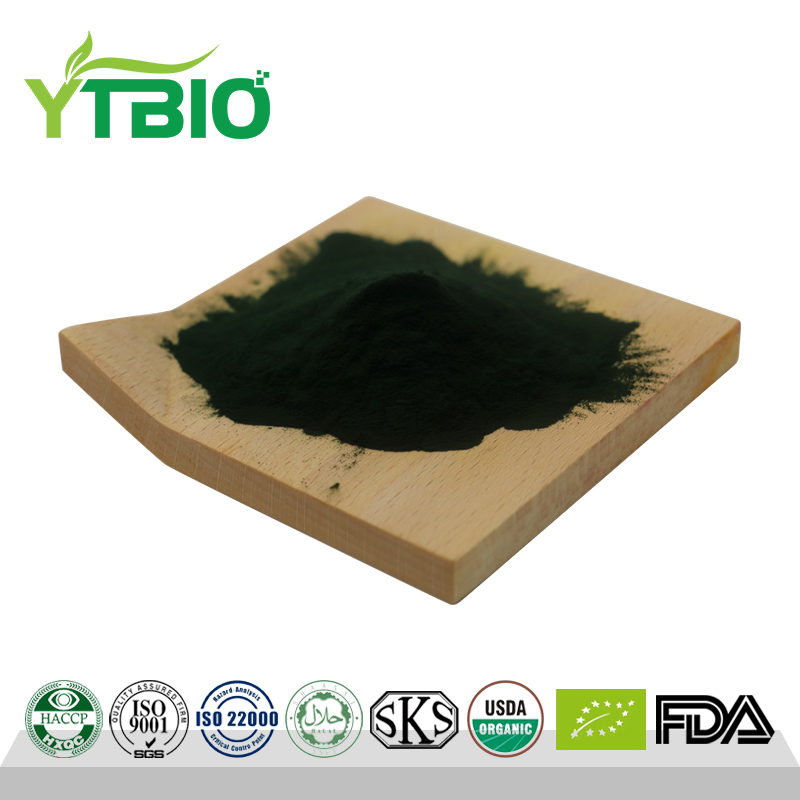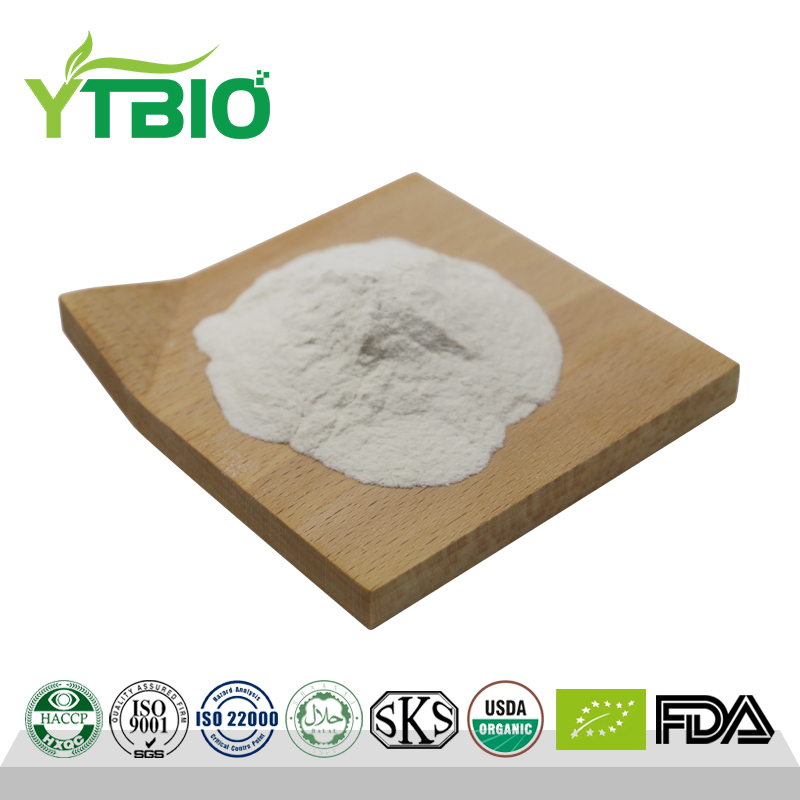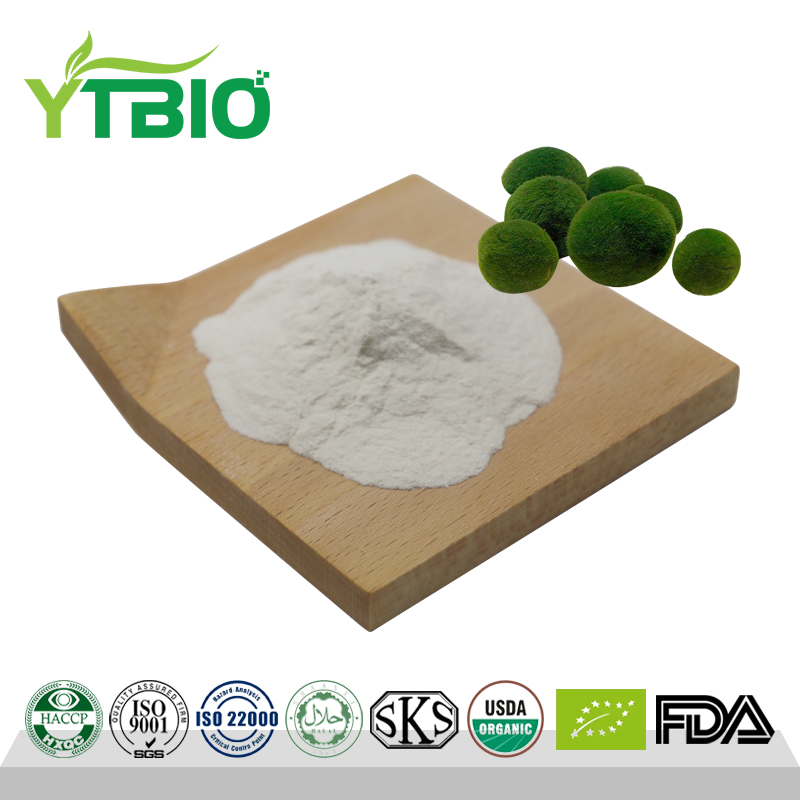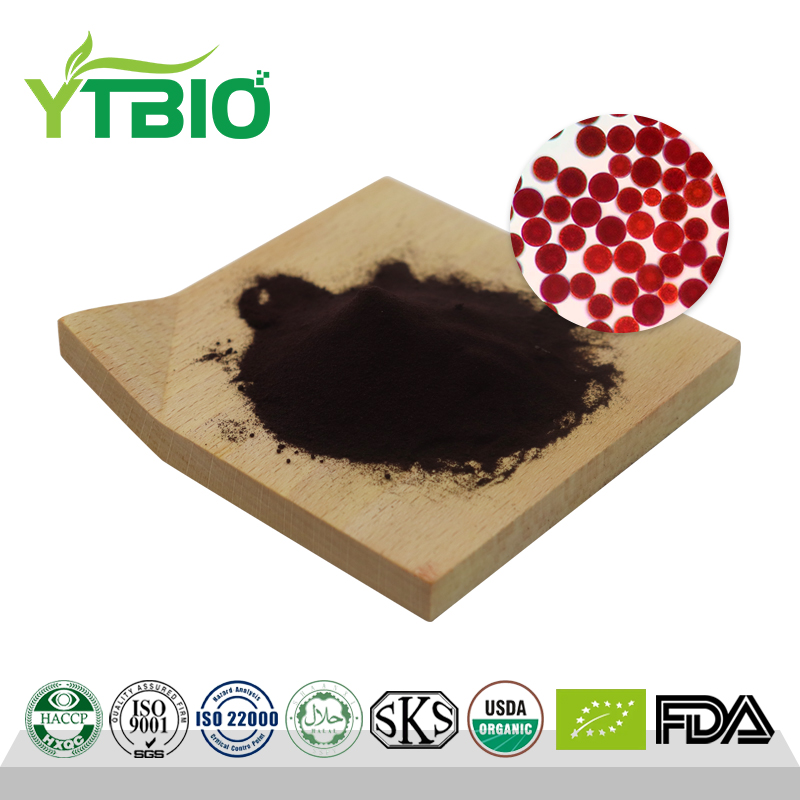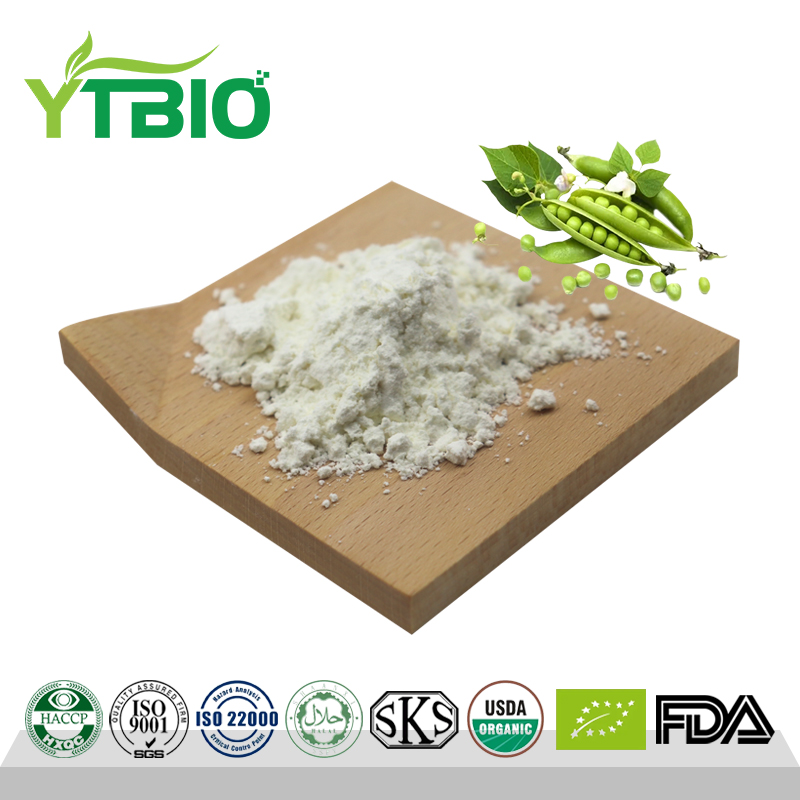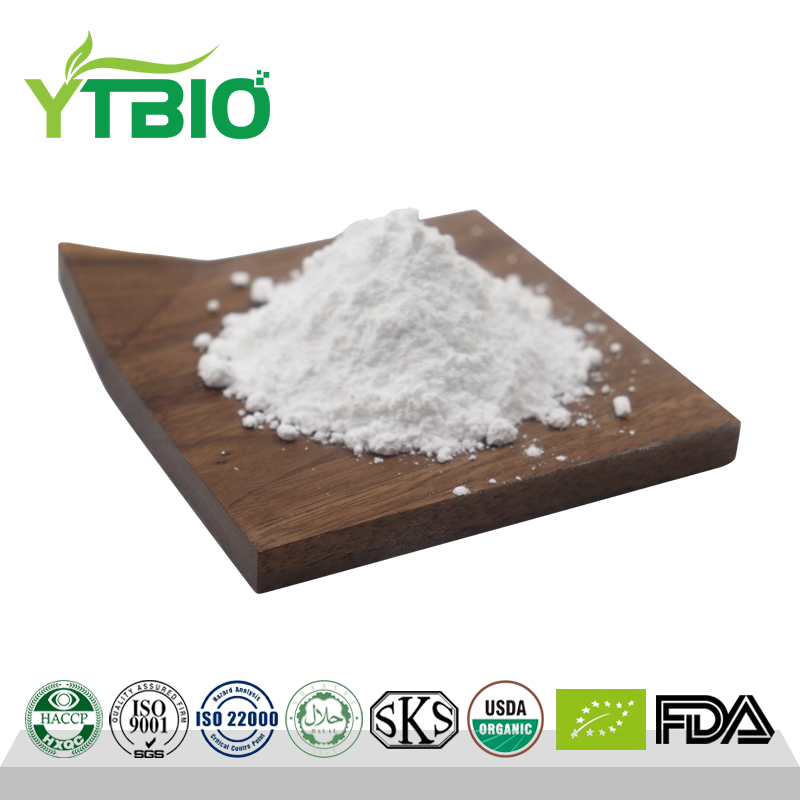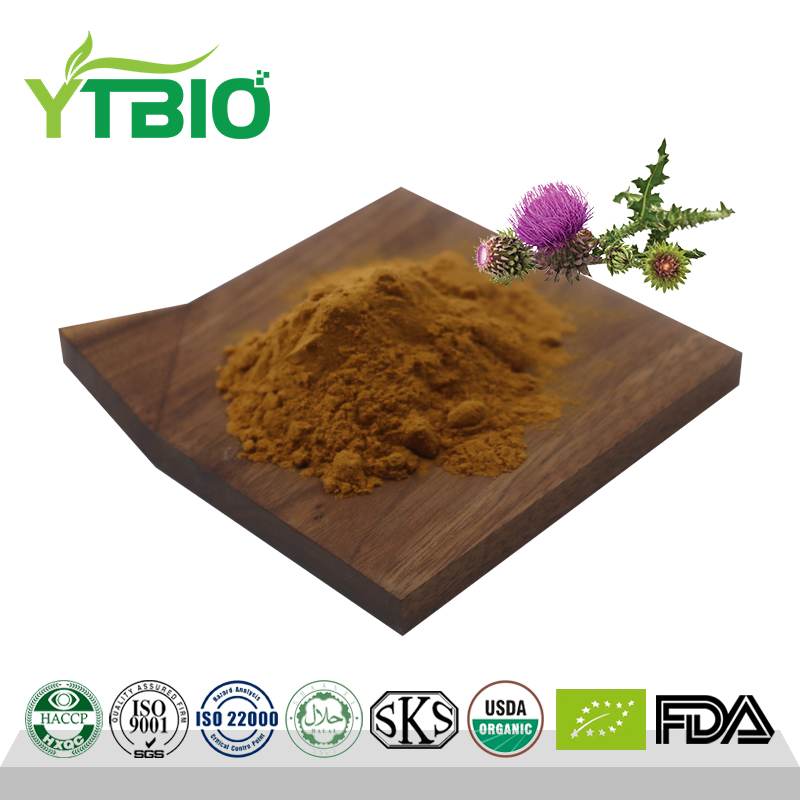Natural Astaxanthin Powder Haematococcus pluvialis extract
What is astaxanthin?
Astaxanthin is a ketone or carotenoid that is fat-soluble, insoluble in water, and soluble in organic solvents. It exists widely in the biological world, especially in the feathers of aquatic animals such as shrimps, crabs, fish and birds, where it plays a coloring role. Astaxanthin is a carotenoid that is not a source of vitamin A and cannot be converted into vitamin A in animals. Astaxanthin is a fat-soluble and water-soluble pigment that is found in marine organisms such as shrimp, crabs, salmon, and algae. The human body cannot synthesize astaxanthin by itself. It is the strongest antioxidant in nature. Its antioxidant activity is 550 times that of vitamin E and 10 times that of beta-carotene, so it is called the "King of Antioxidants"!
Astaxanthin is a chain-breaking antioxidant. It has strong antioxidant ability, can remove nitrogen dioxide, sulfide, disulfide, etc., can also reduce lipid peroxidation, and effectively inhibit lipid peroxidation caused by free radicals. At the same time, it has various physiological effects such as enhancing immunity and scavenging free radicals in the body. It has a good therapeutic effect on skin problems caused by ultraviolet rays and has a preventive and therapeutic effect on eye diseases caused by diabetes. It is widely used in health products, medicines, cosmetics, and food additives. It has broad application prospects in aquaculture and aquaculture.
In addition to using biological extraction methods, astaxanthin can also be produced by chemical synthesis, algae, bacteria, yeast, etc. In addition, the application of DNA recombinant technology to construct high-yield astaxanthin genetic engineering is also under research.
What are the benefits
1. Antioxidant function
Astaxanthin has the effects of protecting skin and eyes, preventing cardiovascular aging, resisting radiation, and preventing and treating Alzheimer's disease. Aging of the human body is mainly caused by oxidation caused by free radicals. Astaxanthin enters human cells, directly removes oxygen free radicals in cells, improves cell regeneration ability, and maintains normal human body functions.
Researchers have been developing new antioxidant substances: the first generation antioxidant substances are vitamins; the second generation antioxidant substances are β-carotene, SOD, coenzyme Q10, etc.; the third generation antioxidant substances are anthocyanins, blueberries Extract, grape seed extract, green tea pigment, lycopene, lipoic acid, etc.; the fourth generation antioxidant substance is natural astaxanthin. Research shows that the antioxidant activity of astaxanthin in Haematococcus pluvialis is much higher than that of beta-carotene, grape seed extract, lipoic acid, lutein, and vitamin E.
2. Protection against ultraviolet radiation
Ultraviolet radiation is an important cause of epidermal photoaging and skin cancer. Astaxanthin's strong antioxidant properties can make it an effective photoprotectant, scavenging free radicals that cause skin aging, and protecting cell membranes and mitochondrial membranes from oxidative damage. Prevent skin photoaging.
3. Prevent cardiovascular disease
Studies have shown that astaxanthin can significantly increase HDL and reduce LDL in the body. HDL can increase from 49.7 mg/dL ± 3.6 mg/dL to 66.5 mg/dL + 5.1 mg/dL. Therefore, it is speculated that astaxanthin can Reducing the oxidation of apolipoproteins can be used to prevent coronary heart disease, arteriosclerosis and ischemic brain damage.
4. Enhance immunity
Astaxanthin can significantly affect the immune function of animals. In the presence of antigens, it can significantly improve the ability of spleen cells to produce antibodies, enhance the function of T cells, and stimulate the production of immunoglobulins in the body. Astaxanthin has strong activity in inducing cell division and has important immunomodulatory functions.
5. Relieve fatigue and enhance body metabolism
Astaxanthin can act as an antioxidant, inhibiting the oxidative damage caused by free radicals to the body. Oral administration of astaxanthin can also strengthen aerobic metabolism, improve muscle strength and muscle tolerance, quickly relieve exercise fatigue, and reduce delayed muscle pain after strenuous exercise.
Application direction
Feed industry
The largest market for astaxanthin is in the feed industry, where it can be used as a feed additive mainly for fish (salmon, sturgeon, rainbow trout, sea bream, etc.), crustaceans such as shrimps and crabs, and poultry. As a colorant for aquaculture animals, astaxanthin can make aquatic animals appear brightly colored, making them more ornamental; adding astaxanthin to poultry feed can increase the yolk content of eggs; it can also improve the quality of hens. improve the egg production rate and promote the health of laying hens. Astaxanthin has the same function as it does for humans in preventing and treating diseases in fish, shrimps, crabs and poultry. It can improve immunity and improve survival rates. It plays an important role in their normal growth and healthy breeding, and in improving survival and reproduction rates. Astaxanthin can also increase the flavor of fish. It can directly serve as a precursor compound to form the flavor of salmon food, and can also promote the conversion of fatty acids or other lipid precursors into salmon flavor compounds.
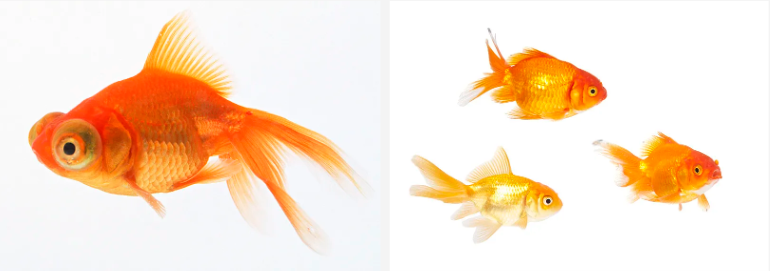
Cosmetic
As a new cosmetic raw material, astaxanthin is widely used in various cosmetics such as creams, emulsions, lip balms, and skin care products due to its excellent properties. Especially in the field of high-end cosmetics, natural astaxanthin, with its unique molecular structure and its antioxidant effect, can effectively quench free radicals caused by ultraviolet rays, prevent skin photoaging, reduce UVA and UVB damage to the skin, and prevent It can prevent the occurrence of skin cancer, delay cell aging, reduce skin wrinkles, reduce melanin deposition, and reduce freckles. It can maintain moisture and make the skin more elastic, tensile and moist.

Food health food
Overseas, astaxanthin has been used as a food additive for food coloring, preservation and nutrition. Astaxanthin is fat-soluble, has a bright red color and has strong antioxidant properties. It has both a coloring effect and a preservation effect on foods, especially foods containing a lot of lipids. Research on the use of astaxanthin to synthesize human health products has long been carried out abroad, targeting its functions in strengthening the immune system, protecting the retina from ultraviolet radiation and photo-oxidation, anti-inflammation, and preventing oxidative damage to blood low-density lipoprotein (LDL)-cholesterol. Sex, develop health products containing astaxanthin.
Drug
The antioxidant and immune-promoting effects of astaxanthin can be used to make drugs to prevent oxidative tissue damage. Studies have shown that astaxanthin can pass through the blood-brain barrier and protect the nervous system, especially the brain and spine, and can effectively treat ischemic repetitive perfusion injury, spinal cord injury, Parkinson's syndrome, Alzheimer's syndrome and other central nervous systems Damage; effectively prevents retinal oxidation and photoreceptor cell damage, and has good effects in improving retinal function. This research result has been patented.



